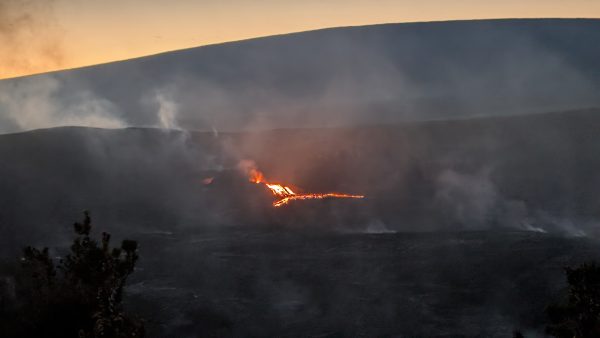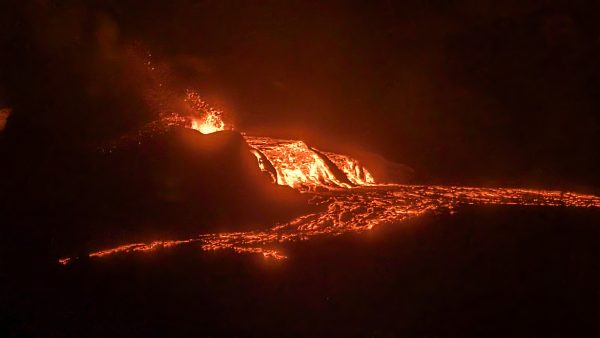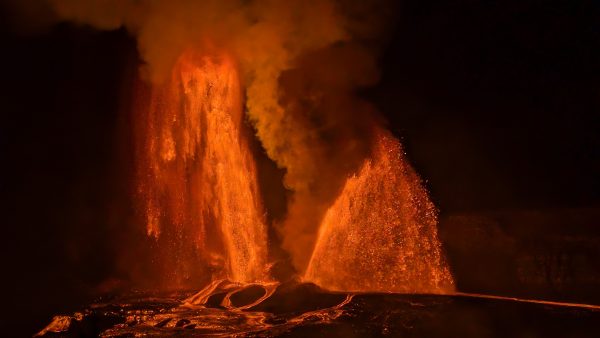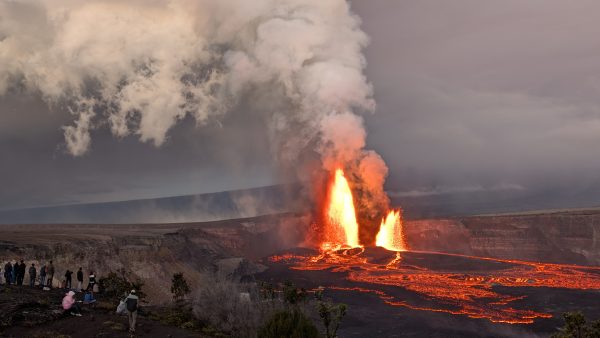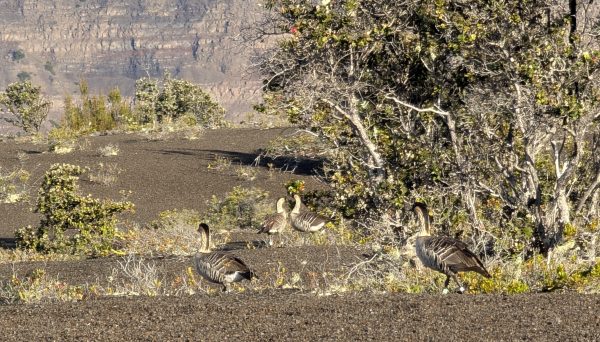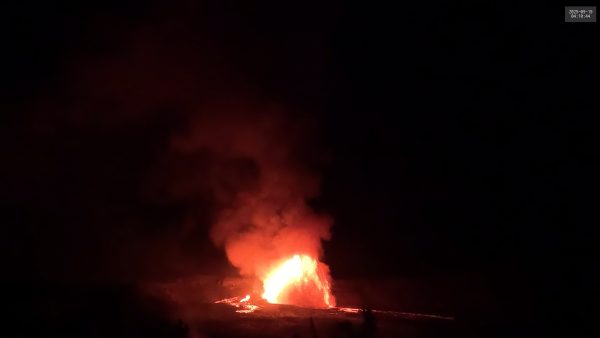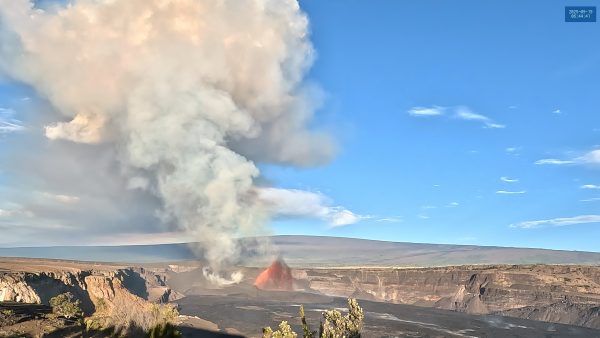Posted on
Posted on
Posted on
Slot Geyser, 2025
Posted on
Tilt Geyser, 2025
Posted on
Oblong Geyser, 2025
Posted on
Grand First Overflow, 2025
Posted on
Grand Geyser Starts, 2025 (Pt. 6)
Posted on
Grand Geyser Starts, 2025 (Pt. 5)
Posted on
Grand Geyser Starts, 2025 (Pt.4)
Posted on
Kilauea Eruption Episode #34 Timelapse
Posted on
Changes at Hveradalir, Iceland.
Passing along an online report on changes at the Hveradalir geothermal area in Iceland that were posted at Iceland Monitor site.
Increased visible steam has been observed along the national highway through Hveradalir.
Geophysicist Ari Trausti Guðmundsson says that steam vents often form at relatively shallow depths in areas of geothermal activity and near hot springs.
“The best example is in Hverahlíð, south of the road leading up to Hellisheiði, where drilling was carried out for the Hellisheiði Power Plant. Suddenly, steam began rising from the hillside somewhat farther east,” he says.
Photos: Steam rising from the ground near the Ring Road
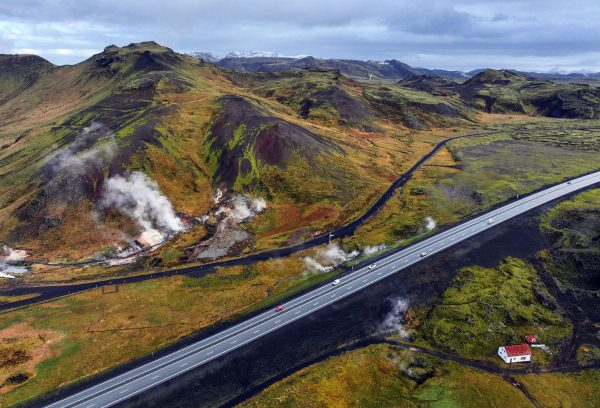
Back in August 2024 there was a landslide in the same area that exposed some buried features.
The landslide that took down material from the southeast side of Skíðaskálinn in Hveradalir in mid-July has probably broken the top layer of the soil above a steaming hot spring.
It is most likely that the combination of steam activity and high precipitation caused the landslide to occur at this time.
Photos: The landslide appears to have exposed a steam geyser
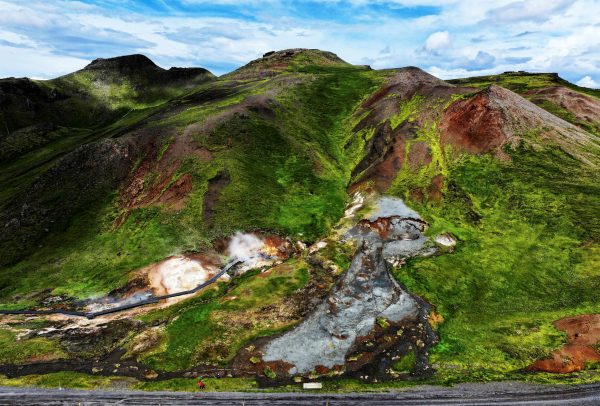
The main thermal area has a walkway and is easily accessible from the highway. We stopped in there when we visited in 2023. I remember a report from back then about steam appearing along the highway, visible in a traffic webcam view, but can't find that report now. So this activity may not be that new.
Posted on
Kilauea Eruption, Episode 34, 2025 October 01
The wait, despite the shorter expected interval, was longer this time. It started with the first visible pooling of the lava on the webcam at 2000. We continued to watch until we saw overflow at around 2145. Decided it was time to head over and start observing in person.
Arrived shortly before 2300, and did not witness another overflow until 0215. There was another almost two hours later. it was fairly strong, and lasted around 11 minutes.
The intervals were about one hour apart until 0700, with longer durations, when they started to decrease. By 1530, they had dropped into the 6 to 8 minutes range. This was starting to look the preliminary activity before the previous eruption.
All of these overflows seemed to have the effect of slowing raising the lip and bottom of the lava waterfall, with the bottom rising faster. There seemed to be less distance between the two by the time of the eruption start.
This state of affairs continued until 2100, when I decided to head back to the parking area and do some watching via webcam, which actually had a better view of the vent when it came to details.
The lot was full, but there was some turnover. A lot of the vehicles were running their engines, i guess because it was humid and foggy, and if you didn't open the windows, it fogged up inside.
The overflows stopped by the time I got to the car, and after several hours of absolutely nothing happening, Suzanne also returned and we went back to our accommodations to eat, recharge dead batteries and get a little sleep.
it was now well into 30 September, which was supposed to be our last full day of the trip. We had the webcam on the wall screen the whole time, and nothing continued to happen until noon approached. By then we decided to return to the parking lot to secure a space, if any were available.
We wasted some time since the overflows were still intermittent. The parking lot had a number of empty spaces when we arrived, but these were slowly filling up. The people started using the parallel spaces, and we decided it was time to return to the overlook.
We managed to replace our previous view spot, as there weren't many there. I didn't notice anyone who looked like they were waiting like we were, as we had the only chairs out there.
The second round of overflow ended around 1900. A couple of hours later I did as the night before, headed back to the car to reconfigure. Dozed off and just before midnight decided to check the camera again. There was heavy overflow from the vent, so called Suzanne to find out when it started. She said she was about to call me. I quickly got myself together, and a half hour later was back out. The sky was glowing red for the last half of the mile walk.
For the next half hour the flow did not let up, and then it seemed like the doming over the vent was turning to jetting. The USGS start of the eruption was put at 0053. For the next hour the height of the jetting got taller, surpassing the height we had seen in the previous eruption. Then at just before 0145, the glow in the South vent began to get brighter. First lava poured out, then it too began jetting. Within a couple of minutes its height was greater than that of the North Vent. And it continued to get higher.
At their best, I was estimating 240 to 300 m/800 to 1000 ft for the North Vent, and 350 to 450m/1200 to 1500 ft for the South. I've not seen a report for the North, but the USGS put the south at 1300ft, so my estimates were in range.
With the eruptions so tall, there was little liquid lava running down the slopes. Instead there was a stead rain of solidified lava. At times the jets were obscured by a curtain of this material. We could also see it being swept upwards by the convection current, which made height estimation a bit difficult.
With two lava columns, we could feel a bit of warmth coming from that direction, surprising considering the distance.
It wasn't until about 0400 that it started to look like the height was decreasing. Around 0530 I thought that the power of the columns was decreasing, but they kept coming back.
By then it was getting light. The night started out clear, but as it got lighter, the clouds turned to mist. It never turned into rain, but the area got wet.
Finally, around 0650 it be came obvious that the end was near. The South vent height dropped rapidly, ending at 0700. The North Vent continued for another three minutes before it also quit.
For the first few hours the crowd was well behaved. Around 0300 the Asian selfie mobs started to appear. At one point the took over a huge area beyond the rope boundary to the left of us, and proceeded for the next hour to prance around making idiotic poses and gang gestures. It got kind of tiring to see these same gestures over and over by people who seemed to be under the impression they were being witty and original. At a couple of points we had to yell at some of the selfie gaijin, as they were stop waving their overly bright lights in our direction, or getting too close to the cliff edge slope. I came to the conclusion that the best way to describe these people is that "they were not here to see the volcano erupt, but to be seen at the volcano eruption". It would have been easier and cheaper, in both time and money, so do their antics in front of a large screen projector. (I hope and expect to see so-called AI created selfies in the near future. Then maybe the selfie plague will end when no one will believe you were there.)
Just before the eruption ended, at dawn, a flock of nene (Hawaiian geese) flew behind us. As in Yellowstone, it appears they commute into an area in the morning, hang around for the day, then disappear at sunset. We saw them (with multiple tourists getting too close) on our way back to the parking lot.
The order of events we saw were quite similar in both eruptions we saw, but more drawn out this time, despite the shorter interval. At times it seemed the volcano was deliberately going slow to make sure we could not make our original travel plans for home. As it was, the eruption started after our deadline for leaving. Fortunately, we had alternate flights booked, and were easily able to extend the car rental. It was midday after the eruption ended when we were able to find a place to stay.
On the evening of 02 October, I felt the 3.7 earthquake at 2029 located just south of Pahala. It was like the rumbling for a second of a piece of heavy equipment (electric generator, for example) starting up. Outside, the frog noises, which are loud and constant much of the night, decreased for a moment or two. Suzanne didn't feel a thing.
Posted on
Kilauea Eruption, Episode 33, 2025 September 19
Since the last visit in December, what can be seen of the volcano has changes, as the level inside the crater has come up considerably, and the vents are now at the top of a large cinder cone. Spent a couple of days checking out the various viewpoints to determine which one best suited our needs. The viewpoint off the old Crater Rim Road before from the Keanakako'i Crater still seemed the best, although just down the road across from the crater seemed possible.
Across from the Kilauea Military Camp along the rim, between the trees, were a number of viewpoints with direct views at the vents, but these would view an inclined eruption column head on. It was from one of these at around 0838 on the morning of 17 September that we saw the first lava overflow for the upcoming eruption episode. Saw two from there, indicating that it was time to start paying attention.
We arrived around midnight to start 18 September. We decided to try the farther overlook, to stay away from the crowds at the main overlook. We had the area to ourselves, and started watching the overflows. The overflows were quite consistent, lasting about two minutes and occurring every seven to nine minutes. This location was a bit breezy, and during much of the night until dawn it was damp from a consistent mist that never really turned into rain.
Around noon the overflows stopped. We returned to the car and the parking lot to get out of the wind for a while. A couple of overflows around 1400 got us back out, but these overflows again stopped, with nothing going on until sunset. We decided to go back to the car to get a nap and wait for something to happen. By 2100, nothing had, se that was when we decided that we needed to return to our cabin to rest up, have something to eat, and recharge our various powered devices. Put the V1 webcam view on the wall screen and waited.
Around midnight (again) we saw the first lava overflow since sunset, and knew it was time to head out. The parking lot was half empty, which was a pleasant surprise. We had thought that there would be a considerable number of people waiting. Decided that were we had waited the day before was too windy and exposed, and would need to join the rest of the crowd. We left our cabin at 0100, arrived at the parking lot 15 minutes later, and walked out to the main overlook, arriving around 00:45. The overflow had continued, or restarted before we arrived. (The glow was consistent on the walk out.) We found the rope line pretty much filled with people waiting. Found a spot that gave us an unobstructed view, and started another wait.
This time the overflows were more irregular and longer. A couple of hours later we got the strongest one yet, and it looked as if it was finally going to go into a full eruption. The USGS start time was 0311, but from our point of view it had started well before that.
Unlike a geyser, where the maximum height is near the start. This eruption took its time, at least a half hour, to slowly reach full height. For this eruption, that height seemed around 225m/750ft, and it stayed there for several hours.
Several times during this period, starting at 0400, the South Vent started to overflow, then well up strongly for a minute or two. It looked like it too was about to start erupting, but it never did. By dawn this activity had subsided.
Before dawn there was an influx of people who seemed to only be there to take selfies, no matter what the volcano was doing, so they got lucky to see an eruption. By sunrise most of the people waiting overnight had left.
Just before noon the South Vent overflowed again, the first time in daylight. With the second overflow, it seemed apparent that the eruption was ending. Over a matter of a couple of minutes the North Vent eruption height dropped, and then it quit.
People applauding the end of an eruption is not just a Yellowstone Grand Geyser phenomena. That happened with the end of this eruption.
There seemed to be a large contingent of people arriving just after the eruption ended. Overheard a few mentioning that they were staying at resorts in the Kona area, which is well over two hours drive away. So I would suspect these are people who hadn't intended to be hear, but in the morning heard of the eruption and headed over, leaving at the start of Tourist Hours (1000-1700), arriving just in time to miss everything.
Posted on
GeyserLog 4.1.1

GeyserLog 4.1.1 is available on the iOS AppStore.
Added SMS note support and fixed a few bugs found during field testing:
- Fixed issue where edited changes could be lost in the event submission view.
- Fixed crash in GrandWait summarizing Turban events.
Once again, geyser gazers are welcome to contact me to get a Promo Code which will allow downloading of the app for free. I'm also open to suggestions for features users would like to see added, or finding out about bugs that need to be fixed.
Posted on
Yellowstone Radio — 2025
Haven't done this in a few years, but during the first visit back in May and June, there was enough strange calls that I decided to try it again this latest trip.
20 Aug
- At Lower Station, RV hits awning with roof air conditioning unit, left area, probably not aware of the damage.
- Motorcycle vandalism call at VC parking lot. Culprit was a raven.
- After sunset, but while still light, report of wrong way driver at exit to Firehole Canyon Drive.
21 Aug
- Person in SUV coming through the south entrance with smoking joint visible
- Two calls in 1/2 hour of wrong way travel on OF entrance roads.
- South of Fountain Flats Dr a gravel truck partially spilled a load, causing damage to several cars. One was undriveable due to windshield damage.
22 Aug
- At 0630, actual fire in Lodge employee kitchen
- C-Tour bus entering Midway parking lot going in left/wrong lane
- Someone very upset over her entrance station experience, including verbal abuse and throwing maps back. Got verbal warning for "discon" — disorderly conduct.
23 Aug
- Seven Romanians warned for thermal trespass at Midway.
24 Aug
- Replacing a dumpster at the VC that got hit and no longer opens.
- Gate runner— excuse was he was coming in to tow out "boss' truck" on trailer. Got a court date for failure to pay, and operating commercial vehicle. Escorted out when noticed he was attempting to do a U-turn and not leave.
26 Aug
- Cowbird with string wrapped around leg at OF boardwalk. Not sure what to do.
- In afternoon, tent set up at turnout just west of Madison Campground.
28 Aug
- Rear end collision at crosswalk next to ranger station results it two vehicles in need of towing.
- Visitor assist at Riverside. Woman at the Dan Wenk Memorial Vault needs assistance as she has dropped her iPhone into the pit. (They are supposed to be water-resistant…) Phone was retrieved and successfully recovered.
29 Aug
- Vehicle in VC parking lot "being attacked by raven."
- In looking for the assault ravens, encountered littering. Contact had two prior IMARS in recent years: Assault, and dog off leash and obstructing traffic.
- Porcupine carcass removed from road near Biscuit Basin.
31 Aug
- "Discon"-- woman trying to "save a spot" in lot beside Lodge was nudged twice by a car wanting that spot real bad.
- Responding ranger commenting on previous entry, "looks like mid-July out here."
- Updates to earlier nudging report: Soon after the initial calls from the parking lot, the comm center was able to determine that the driver had reservations at Fishing Bridge. Driver was later contacted and given a verbal warning for disorderly conduct.
01 Sep
- Morning call about messy, post-party Madison campsite. Mostly empty cartons and containers, no actual food. Verbal warning, but leaving today.
- Trash container at Lone Star trailhead is overflowing.
- A long one-- report of erratic driving for a car heading north from Old Faithful, including near head on collisions. LE quickly catch up north of Fairy Falls and witness similar behavior. Turns out the driver has suspended driver's licenses from both Wyoming and Montana and has a outstanding warrant for immigration violations. Two people in the car, and neither person can speak English. Companion has no identification. Driver gets a trip to Mammoth. The companion claims to be a juvenile, and they have problems trying to figure what to do with him. They tried to call what was supposed to be a family member in Bozeman, and got a hangup.
- At Madison campsite, occupants have dug a large hole that is a tripping hazard.
- Also at Madison. Someone reporting that their hatchet and two boxes of wood are missing from their campsite.
04 Sep
- Report of woman lying down between parked card in the lot behind the Lodge. When contacted, ran off into the words toward the cabins. Later found near the Rec Hall behind the Lodge. Arrested for intoxication. Also looking for a Prius with expired registration, maybe possible breakup with driver of car.
- Because of this previous incident, "no one available right now" was the response to "thermal trespass" at Giantess.
- Someone in VC giving Old Faithful information/prediction on NPS West Direction channel. Gets the Comm Center response: "Unit on Direct. You are not on Common."
05 Sep
- Raccoon inside vehicle parked behind Inn. It appears to be a pet.
06 Sep
- At Midway — citation for parking in gov't reserved parking space.
07 Sep
- In East Lot — ravens looting the back of a pickup truck.
08 Sep
- Written warnings to at least four vehicles in the "make your own parking space" line between Lower Ham's and the Gas Station. One of them also had plates which expired on 29 Feb 2024.
- Madison Campground host calls for attitude adjustment at particular campsite. Warning issued for off-road vehicle and for food storage.
- After sunset, escorting a wide load from OF to West Yellowstone.
Posted on
Observations for 2025 September 10
A moonlight Beehive eruption in the early morning, except the moon was hidden by some clouds. Along with the lights from the Inn, there was still enough to see it, so that it didn't need to be lit up.
While passing by Sulphide on the way back we caught a smell I've never encountered in this area before, that of a skunk. Didn't notice it on the way out, and was localized to just that area.
A few hours later, in the time it took to go into the Lodge and check out from our cabin, two ravens managed to open the pocket on my bike handlebars and empty the contents out onto the pavement.
Posted on
Observations for 2025 September 09
By getting out at the eight hour mark, only ended up waiting for Grand for an hour. It was cold and clear, so the moon was bright. The One Burst Grand eruption was short enough that it could've had a second burst, but the slowing down during the final minute seemed like an indication that once it ended, Grand wasn't going to restart.
2025-Sep-09 : 03:16:04 T1C 03:16:00 Turban -0m04s 03:16:04 B1 --- d=08m54s 03:18:25 Vent 2m20s 03:24:59 P1 8m54s Vent & Turban continue ΣD=08m54s * * * * * 02:33:28 d=03m46s 02:52:33 Int: 19m05s d=03m33s Turban: 23m27s
Beehive erupted just before the start of the Grand eruption window, so many were able to see both eruptions. Ended up waiting for about 1-1/2 hours before the start of a West Triplet eruption, then we needed to wait until West Triplet was nearing the end of its eruption before we got another One Burst Grand eruption.
This eruption had a definite false pause around the nine minute mark before its sudden resumption of activity for another 1-1/3 minutes. West Triplet quit at about the same time as Grand, and Rift still hasn't made an appearance in several days.
2025-Sep-09 : 12:24:12 T1C 12:23:13 Turban -0m59s 12:23:33 Vent Ovfl -0m39s 12:24:06 Boop -0m06s 12:24:12 B1 --- d=10m19s 12:26:44 Vent 2m32s 12:33:11 FP 8m59s 12:34:31 P1 10m19s Vent & Turban continue ΣD=10m19s * * * * * 10:38:42 d=04m02s 10:55:56 Int: 17m14s d=03m38s 11:14:29 Int: 18m33s d=03m19s 11:31:11 Int: 16m42s d=03m35s 11:48:37 Int: 17m26s d=03m41s 11:58:16 West Triplet 12:06:00 Int: 17m23s d=03m37s Turban: 17m13s
It was after sunset, but still light, as I headed out for the next Grand eruption. As I approached the signboards and junction by the lift station, I noticed three deer right next to the bike trail. One ran across the trail into the trees, while the other two stared at me for a few moments, then went bounding off into the meadow toward Old Faithful and Geyser Hill.
I had just tied down my bike at the bikerack near Castle, and was walking toward Crested Pool when Castle started to erupt. It being a windy day, I quickly went the rest of the way toward Tilt to watch what turned out to be the second major eruption of the day. By that time I'd already seen that Rift was in eruption.
Rift erupted for another hour. Two Turban eruption intervals after Rift had quit, Turban had a strong, but short eruption. The next interval was short, and there was little overflow from Grand. So it wasn't a total surprise when the next Turban eruption started strongly. Others waiting for Grand were illuminating it, and I could see at least one boop before the One Burst Grand eruption started. Once again, we got an eruption lasting less than ten minutes with no attempt at a second burst.
2025-Sep-09 : 21:35:42 T1C 21:35:24 Turban -0m18s 21:35:37 Boop -0m05s 21:35:42 B1 --- d=09m30s 21:38:19 Vent 2m37s 21:45:12 P1 9m30s Vent & Turban continue ΣD=09m30s * * * * * 20:04:06 d=03m14s 20:22:18 Int: 18m12s d=03m22s 20:41:44 Int: 19m26s d=03m59s 20:59:36 Int: 17m52s d=02m58s 21:16:38 Int: 17m02s d=03m06s Turban: 18m46s

